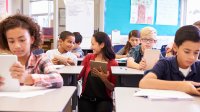A Path to Improving Students’ Emotional Intelligence
Teachers can merge social and emotional learning and student choice to guide students to better understand themselves.
Your content has been saved!
Go to My Saved Content.Emotional intelligence includes the capacity to recognize and manage moods and emotions in real-world situations. Considered the starting point of social and emotional skill development, emotional intelligence can also predict future academic success.
Many educational technology tools can support emotional intelligence development. For instance, Pear Deck’s guided slide show tool features social and emotional learning (SEL) templates for Google Slides and Microsoft PowerPoint. In my teaching, I have used the interactive Stress Check thermometer, which students can use to check in along a range indicating whether they are in a good space to focus or if they’re having difficulty managing emotions today.
Other slides are open-ended, asking students what fills—or what drains—their metaphorical buckets. When I did this activity with my students during remote instruction, answers varied widely. Some expressed gratitude for friends and family, while others shared uncertainties. In fact, they were appreciative that I had asked at all. After students checked in, a discussion around self-care strategies took place.
In addition to Pear Deck, Nearpod and Microsoft Teams offer SEL tool sets. Some teachers also use surveys, like Google Forms, to check in with students. These may also include reflective activities, as well as mood boards—images of emotive faces along with feelings words (happy, calm, sad) that children click on that match their feelings. Some mood boards adapt Gloria Willcox’s 1982 Feelings Wheel, a visual taxonomy of emotions built around core emotions of sad, mad, scared, joyful, powerful, and peaceful. From these, spokes fan out, listing related emotions.
As with many classrooms, the Feelings Wheel hangs in my son’s fifth-grade class. Students use it to recognize and label how they feel at any given moment.
Children Can Become ‘Emotion Scientists’
The Mood Meter is an emotion check-in tool similar to the Feelings Wheel but slightly different in intent. The goal here is for people—not just children—to become what Yale Center for Emotional Intelligence founder Marc Brackett calls “emotion scientists.” In his popular book Permission to Feel, Brackett wrote, “An emotion scientist has the ability to pause even at the most stressful moments and ask: What am I reacting to? We can learn to identify and understand all our feelings, integral and incidental, and then respond in helpful, proportionate ways— once we acquire emotional skills.”
The Mood Meter is not a wheel; rather, it presents emotions in four color-specific quadrants connecting moods to energy levels. Along the numbered x- and y-axes, the red quadrant describes high-energy unpleasant moods, while yellow is where pleasant but high-energy emotions reside. The blue zone contains unpleasant, low-energy moods, and green represents pleasant but low-energy moods.
Use Mood-Aligned Choice Boards
Students’ moods and energy levels can impact how they learn, as well as their behaviors in the classroom. For instance, students who self-report being in the yellow quadrant may be in the mindset to take part in creative problem-solving activities. Conversely, children who have high-energy, unpleasant moods can be led to harness their emotions in classroom debates or Socratic seminars.
In my new book, Gaming SEL, I share gameful strategies to help students develop as emotion scientists in learner-driven environments. More than student-centered, “learner-driven" implies that students feel a sense of control over their education. Learner agency, or autonomy, along with feelings of competence and relatedness, describe three factors of self-determination theory. Self-determination is a basic human need, and sometimes people find other outlets to achieve it when they cannot in their everyday lives. This concept is one of the reasons so many of us play video games outside of work and school.
Choice boards are a strategy that some teachers use as a step toward supporting self-determination. Typically written as a menu of options that students can take to demonstrate learning, choice boards vary. Sometimes resembling a tic-tac-toe board, they can be made digitally using hyperlinks on shared Google or Microsoft Word documents. There are many free templates online, too, including options from SlidesMania. Choice can manifest in physical classrooms as well, with learning centers or stations geared toward specific learning outcomes.
As this video suggests, teachers can create SEL-aligned choice boards that match students’ moods to learning activities, thereby deepening emotional intelligence skills while also engendering feelings of autonomy, competence, and relatedness. In a gamified classroom, choice boards can become quests. Teachers can use tools like Classcraft to wrap student learning as a choose-your-own-adventure hero’s journey.
To level up, students can participate in brainstorming activities on a Google Jamboard if they are in the yellow quadrant or inquiry-based activities if they are in the blue. In project-based classrooms, teachers can align role-play to driving questions, boosting meaning to choices that students make. In a math class, students can approach authentic problems as architects; social students can become archaeologists.
In addition to mood-aligned choice boards, the activities themselves can embed SEL in the curriculum. Consider how students can work together to learn goal setting and team building as skills. Perhaps there are opportunities for learners to cultivate empathy and perspective-taking in lessons, particularly as students reconnect with one another in person, back in physical classrooms.
Self-determination can also be actualized using student choice and voice—a component of project-based learning where passions can drive experiences. If a child loves Minecraft or poetry writing or fan fiction writing and is in the mood to learn, the possibilities are endless.
